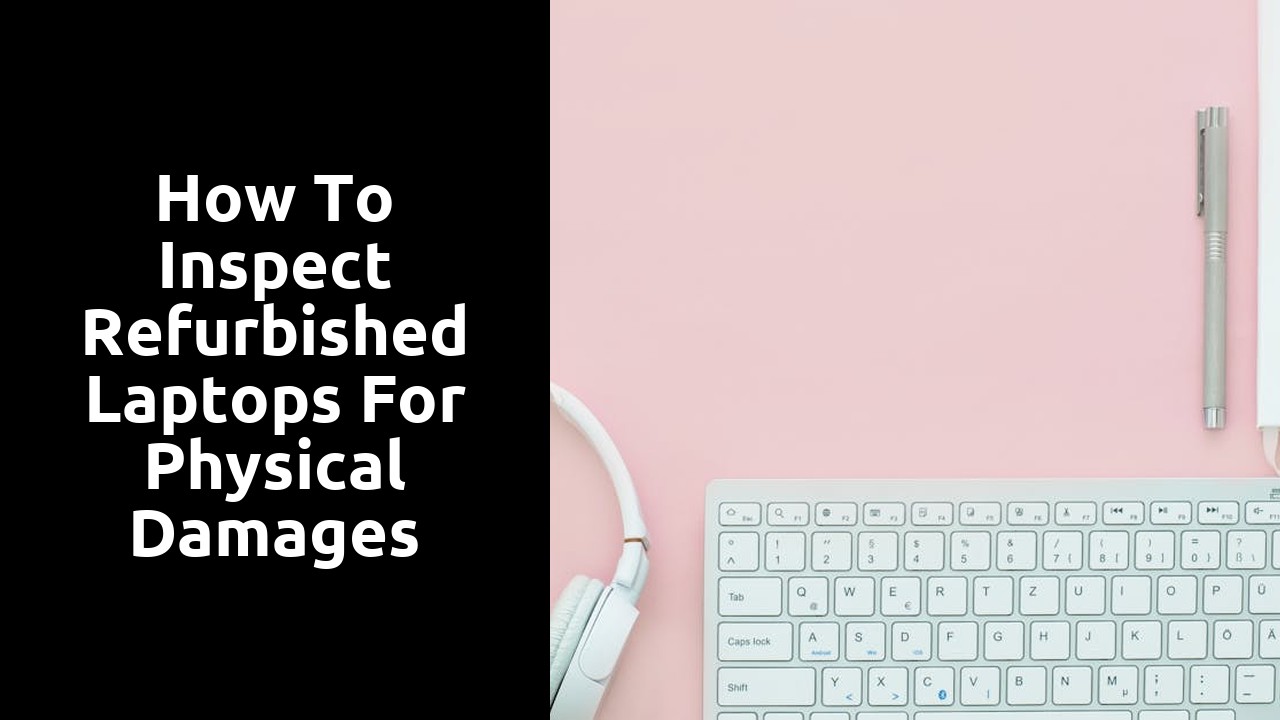
How to Inspect Refurbished Laptops for Physical Damages
Verifying the Battery Health
When inspecting a refurbished laptop, one crucial aspect to assess is the battery health. Begin by checking the overall condition of the battery. Look for any signs of physical damage such as dents, bulges, or corrosion on the battery itself. These could indicate a potential issue with the battery's health and performance.
In addition to visual inspection, verify the battery life and charging capacity of the laptop. Start by charging the laptop fully and then monitor how long it lasts when in use. If the battery quickly drains or fails to hold a charge for a reasonable amount of time, it may be a sign that the battery needs replacing. Conducting these checks will help you ensure that the laptop's battery is in good condition and able to support your needs.
Checking Battery Life and Charging Capacity
Inspecting the battery life and charging capacity of a refurbished laptop is crucial in determining its overall functionality and longevity. When examining these aspects, it is important to first assess the battery health indicator provided by the operating system. This indicator will give you an idea of the battery's current condition and whether it may need to be replaced in the near future.
Next, test the laptop's charging capacity by observing how quickly the battery charges and how long it holds a charge. Plug the laptop into a power source and note the time it takes for the battery to reach 100%. Then, unplug the laptop and monitor how long it lasts on a full charge with normal usage. This will give you a good indication of the battery's overall health and efficiency.
Checking the Laptop Exterior
When inspecting the exterior of a refurbished laptop, it is crucial to pay attention to any signs of wear and tear that may indicate the device's previous usage. Look closely at the laptop casing for scratches, dents, or any other physical imperfections that could impact its functionality or aesthetics. Additionally, check the screen for any cracks or dead pixels that could affect the display quality.
Moreover, take a thorough look at the keyboard and trackpad to ensure that all keys are functioning correctly and that there is no visible damage. Test each key and trackpad gesture to make sure they respond as expected. Lastly, inspect the ports and connectors on the laptop to ensure that they are not damaged or loose, as this could affect the device's connectivity and usability.
Looking for Signs of Wear and Tear
When examining a refurbished laptop for signs of wear and tear, pay close attention to the casing, keyboard, and screen. Scratches, dents, or discolouration on the laptop's exterior may indicate rough handling or prolonged use. Additionally, check the keyboard for worn-out keys, sticky buttons, or missing pieces, as these issues can affect the laptop's usability and aesthetic appeal.
Moving on to the screen, inspect it for any dead pixels, flickering, or discolouration. Such visual defects can be distracting during use and may worsen over time. It's essential to thoroughly scrutinise these areas to ensure that the refurbished laptop meets your standards in terms of appearance and functionality.
Evaluating the Laptop Performance
When evaluating the performance of a refurbished laptop, it is crucial to test its speed and efficiency under various conditions. Run multiple applications simultaneously to gauge how the laptop handles multitasking. Pay attention to any lag, delays, or freezing that may occur, as these can indicate potential performance issues. Additionally, assess the responsiveness of the laptop when executing commands and switching between different programs.
Furthermore, testing the laptop's boot-up time and shutdown speed is essential in evaluating its overall performance. A quick boot-up time signifies that the laptop's operating system is running smoothly, whereas a slow boot-up could indicate underlying issues that may affect the laptop's performance in the long run. Similarly, observe how swiftly the laptop shuts down after the command is given, as this can also provide insights into the system's efficiency and health.
Testing Speed and Efficiency
When evaluating a refurbished laptop's speed and efficiency, it's crucial to take a systematic approach to ensure a comprehensive assessment. First and foremost, run performance tests on the laptop using reputable software to gauge its processing speed and overall efficiency. This will provide valuable insights into how the device handles tasks and processes data, giving you a clear picture of its capabilities.
Furthermore, consider the laptop's multitasking abilities by running multiple applications simultaneously. This will test the device's performance under pressure and help you determine if it meets your requirements for handling various tasks concurrently. By conducting thorough speed and efficiency tests, you can make an informed decision on whether the refurbished laptop is suitable for your needs, ensuring a smooth and reliable user experience.
Related Links
How to Determine Your Needs and Requirements When Buying a Refurbished LaptopThe Ultimate Roundup of Refurbished Laptops
Why Reputation Matters When Buying Refurbished Laptops
Refurbished Laptops: A Comprehensive Review
Top 10 Tips for Buying Refurbished Laptops
A Brief History of Refurbished Laptops
Why You Should Check the Warranty and Return Policy When Buying a Refurbished Laptop